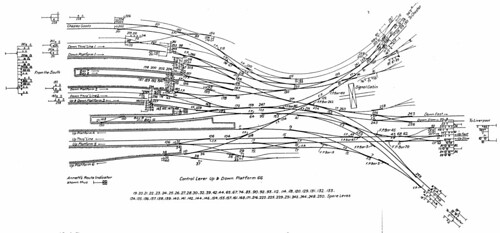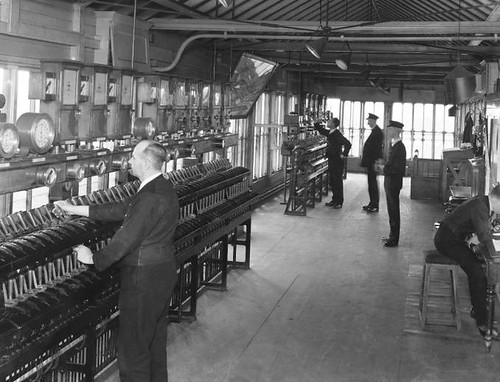Between 1896 and 1907, the railways around Crewe were rebuilt and expanded. The 'Crewe' All Electric System developed by Webb and Thompson was installed at Crewe North Junction and other signal boxes. The system featured electric operation of points and electric operation of fairly standard looking LNWR lower-quadrant semaphore signals.
 Operating floor of Crewe North Junction showing 'Crewe' All Electric miniature lever frames.
Operating floor of Crewe North Junction showing 'Crewe' All Electric miniature lever frames.
The diagram below shows the arrangements at Crewe North Junction after 1906.
 Click here for larger version
Click here for larger versionDiagram of the lines controlled by Crewe North Junction.
This diagram appeared in the book 'Power Railway Signalling' [Reference 1], together with similar diagrams for Crewe South Junction and Salop Goods Junction.
The installation included Annett's Route Indicators on the row of signals controlling platform departures in the Down direction.

A later picture of the operating floor at Crewe North Junction, taken around 1936 (Photo: National Railway Museum).
The Crewe Works narrow gauge railway connected the works site to the station via a single line passing over the 'Spider Bridge', which passed right through the 1906 signal box. The photograph reminded me of the 1956 'novelty number' performed by Vaughn Monroe titled "In the Middle of the House" (lyrics).
 View of Crewe North Junction signal box, from the 'Spider Bridge'.
View of Crewe North Junction signal box, from the 'Spider Bridge'.
In 1940, a replacement signal box using Westinghouse Brake and Signal Company Style 'L' miniature lever frames was brought into use. This replacement signal box is described here.
References
[Reference 1] 'Power Railway Signalling' by H. Raynar Wilson, published c1908, reprinted in two parts by P. Kay (ISBN 1 899890 00 9).
